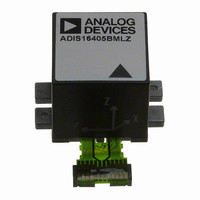ADIS16405BMLZ Analog Devices Inc, ADIS16405BMLZ Datasheet - Page 9

ADIS16405BMLZ
Manufacturer Part Number
ADIS16405BMLZ
Description
MODULE GYRO/ACCEL/MAG 24ML
Manufacturer
Analog Devices Inc
Specifications of ADIS16405BMLZ
No. Of Axes
3
Sensor Case Style
ML-24-2
No. Of Pins
24
Supply Voltage Range
4.75V To 5.25V
Operating Temperature Range
-40°C To +105°C
Termination Type
Through Hole
Acceleration Range
2000g
Interface Type
SPI
Sensitivity Per Axis
3.33mg / LSB
Rohs Compliant
Yes
Filter Terminals
Through Hole
Digital Ic Case Style
Module
Lead Free Status / RoHS Status
Lead free / RoHS Compliant
For Use With
ADIS16405/PCBZ - BOARD EVAL FOR ADIS16405
Lead Free Status / RoHS Status
Lead free / RoHS Compliant, Lead free / RoHS Compliant
Available stocks
Company
Part Number
Manufacturer
Quantity
Price
Company:
Part Number:
ADIS16405BMLZ
Manufacturer:
AD
Quantity:
4
Part Number:
ADIS16405BMLZ
Manufacturer:
ADI/亚德诺
Quantity:
20 000
THEORY OF OPERATION
BASIC OPERATION
The ADIS16405 is an autonomous sensor system that starts up
after a valid power supply voltage is applied and then begins
producing inertial measurement data at the factory-default sample
rate of 819.2 SPS. After each sample cycle, the sensor data loads
into the output registers and DIO1 pulses, providing a new data
ready control signal for driving system-level interrupt service
routines. In a typical system, a master processor accesses the
output data registers through the SPI interface, using the hook-
up shown in Figure 9. Table 6 provides a generic functional
description for each pin on the master processor. Table 7
describes the typical master processor settings normally found
in a configuration register and used for communicating with
the ADIS16405.
Table 6. Generic Master Processor Pin Names and Functions
Pin Name
SS
IRQ
MOSI
MISO
SCLK
Table 7. Generic Master Processor SPI Settings
Processor Setting
Master
SCLK Rate ≤ 2 MHz
CPOL = 1
CPHA = 1
MSB-First
16-Bit
1
The user registers provide addressing for all input/output
operations on the SPI interface. Each 16-bit register has two
7-bit addresses: one for its upper byte and one for its lower byte.
For burst mode, SCLK rate ≤ 1 MHz. For low power mode, SCLK rate ≤ 300 kHz.
SYSTEM
PROCESSOR
SPI MASTER
VDD
Figure 9. Electrical Hook-Up Diagram
I/O LINES ARE COMPATIBLE WITH
1
SCLK
MOSI
MISO
3.3V OR 5V LOGIC LEVELS
IRQ
SS
Function
Slave select
Interrupt request
Master output, slave input
Master input, slave output
Serial clock
Description
The ADIS16405 operates as a slave.
Normal mode, SMPL_PRD[7:0] ≤ 0x08.
Clock polarity.
Clock phase.
Bit sequence.
Shift register/data length.
6
3
5
4
7
CS
SCLK
DIN
DOUT
DIO1
10
13
ADIS16405
5V
SPI SLAVE
11
14
12
15
Rev. 0 | Page 9 of 16
Table 8 lists the lower byte address for each register, and Figure 10
shows the generic bit assignments.
READING SENSOR DATA
Although the ADIS16405 produces data independently, it oper-
ates as an SPI slave device that communicates with system (master)
processors using the 16-bit segments displayed in Figure 11.
Individual register reads require two such 16-bit sequences. The
first 16-bit sequence provides the read command bit (R/W = 0)
and the target register address (A6 to A0). The second sequence
transmits the register contents (D15 to D0) on the DOUT line.
For example, if DIN = 0x0A00, then the content of XACCL_OUT
shifts out on the DOUT line during the next 16-bit sequence.
The SPI operates in full duplex mode, which means that the master
processor can read the output data from DOUT while using the
same SCLK pulses to transmit the next target address on DIN.
DEVICE CONFIGURATION
The user register memory map (Table 8) identifies configuration
registers with either a W or R/W. Configuration commands also
use the bit sequence displayed in Figure 12. If the MSB is equal to 1,
the last eight bits (DC7 to DC0) in the DIN sequence load into
the memory address associated with the address bits (A5 to A0).
For example, if DIN = 0xA11F, then 0x1F loads into Address
Location 0x21 (XACCL_OFF, upper byte) at the conclusion of
the data frame.
Most of the registers have a backup location in nonvolatile flash
memory. The master processor must manage the backup function.
Set GLOB_CMD[3] = 1 (DIN = 0xBE04) to execute a manual
flash update (backup) operation, which copies the user registers
into their respective flash memory locations. This operation
takes 50 ms and requires the power supply voltage to be within
the specified limit to complete properly. The FLASH_CNT register
provides a running count of these events for managing the long-
term reliability of the flash memory.
BURST MODE DATA COLLECTION
Burst mode data collection offers a more efficient method for
collecting data from the ADIS16405. In sequential data cycles
(each separated by one SCLK period), all output registers clock
out on DOUT. This sequence starts when the DIN sequence is
0011 1110 0000 0000 (0x3E00). Next, the contents of each output
register are output from DOUT, starting with SUPPLY_OUT
and ending with AUX_ADC (see Figure 12). The addressing
sequence shown in Table 8 determines the order of the outputs
in burst mode.
15
14
13
UPPER BYTE
12
Figure 10. Output Register Bit Assignments
11
10
9
8
7
6
5
LOWER BYTE
4
ADIS16405
3
2
1
0













